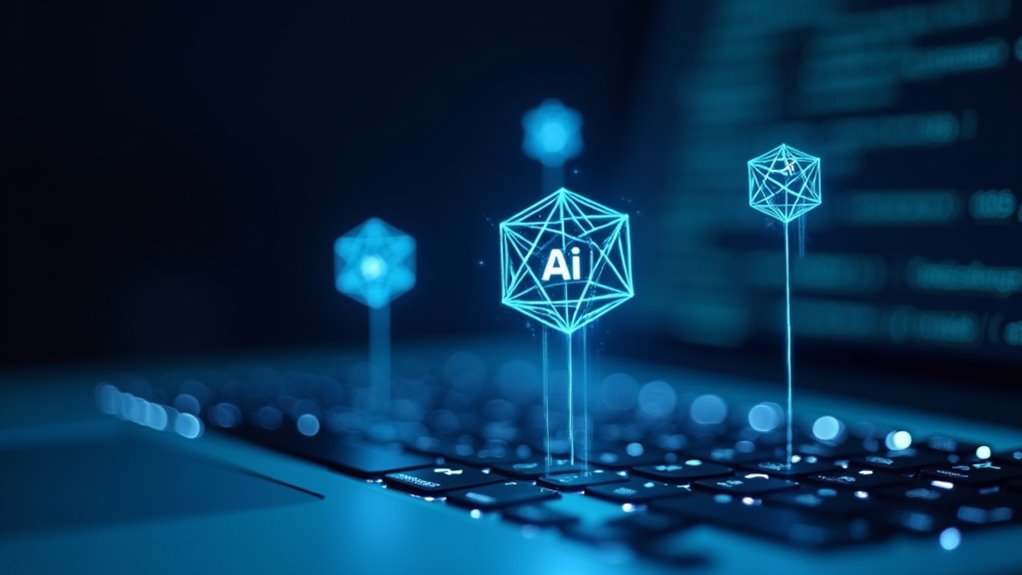Open-foundation AI is a new approach that makes powerful AI models accessible without creator permission. Unlike closed systems, these models (like Meta’s Llama 2 and Google’s Gemma) can be downloaded, modified, and used freely, democratizing technology previously controlled by tech giants. It differs from open-source by sharing model weights without requiring full code transparency. This middle-ground approach accelerates innovation while raising ethical concerns about potential misuse. The future landscape promises both challenges and unprecedented opportunities for those ready to explore.

While tech giants have traditionally guarded their AI systems like digital fortresses, a new paradigm is emerging that’s shaking up the industry. Open-foundation AI represents a fundamental shift in how artificial intelligence is distributed and controlled. Unlike closed systems that remain under strict developer supervision, open-foundation models can be downloaded and used without getting permission from their creators. It’s democratizing access to powerful technology that was once the exclusive domain of tech behemoths.
Models like Meta’s Llama 2 and Google’s Gemma exemplify this approach. They’re powerful large language models that anyone with sufficient computing resources can download and implement. This open access benefit means developers worldwide can build upon existing foundations rather than starting from scratch—saving time, money, and computational resources. Open-foundation AI grants users the freedom to utilize the system for any purpose without requiring permission from the original developers.
Open-foundation AI lets developers worldwide stand on giants’ shoulders, accelerating innovation without reinventing the algorithmic wheel.
The model transparency, while not always complete, offers greater visibility into how these systems function compared to their closed counterparts. You’re not just using a black box; you’re working with something you can actually examine and customize. These models embrace human-centered design principles that ensure AI technologies enhance rather than replace human capabilities.
Open-foundation AI isn’t exactly the same as open-source software, though. While open-source demands full code transparency, open-foundation focuses primarily on making the model weights and architecture accessible. Think of it as getting the keys to drive the car without necessarily showing you every detail of the engine blueprint.
The implications are both exciting and concerning. On one hand, innovation accelerates when more minds can contribute to and build upon existing technology. On the other, easier access means potential misuse by bad actors. Even in healthcare applications, the spread of misinformation through open AI models presents ethical challenges similar to those seen during the COVID-19 pandemic. Regulators are scrambling to keep pace, with frameworks like the EU’s AI Act attempting to establish guardrails without stifling progress.
As this field evolves, the distinction between open and closed AI systems will likely blur further. What’s clear is that open-foundation AI is redistributing power in the tech landscape, challenging monopolistic control, and potentially releasing a new wave of AI applications we haven’t yet imagined.
Frequently Asked Questions
How Does Open-Foundation AI Compare to Proprietary Models?
Open-foundation AI differs from proprietary models in three key areas.
First, cost structure—open source advantages include free distribution with community collaboration reducing development costs, though technical resources are needed.
Second, proprietary models offer faster deployment but less flexibility.
Finally, open models provide complete transparency and customization options, allowing for privacy-focused implementations and innovation.
The trade-off? You’ll need technical expertise to harness open models’ full potential, while proprietary options offer convenience at a premium.
What Licensing Restrictions Typically Apply to Open-Foundation AI Models?
Open-foundation AI models typically come with licensing agreements that range from permissive (MIT, Apache) to more restrictive custom terms.
These dictate model usage boundaries—what you can build, modify, or sell. Companies like Meta and Google often impose non-standard restrictions that limit commercial applications or require attribution.
For businesses, especially smaller ones, these legal mazes can be dealbreakers.
While open models promise accessibility, their fine print sometimes tells a different story. Always check those terms before getting too attached!
Can Open-Foundation AI Be Deployed in Regulated Industries?
Yes, open-foundation AI can be deployed in regulated industries, but it’s not a simple plug-and-play situation. Organizations must guarantee regulatory compliance through rigorous validation, documentation, and risk assessment processes.
These models require additional safeguards when handling sensitive data in healthcare, finance, or legal sectors. While offering flexibility and innovation potential, deployment demands strict adherence to industry standards.
The compliance burden shifts to the implementing organization, requiring robust governance frameworks and continuous monitoring for emerging regulatory requirements.
What Computational Resources Are Needed to Run Open-Foundation AI?
Running open-foundation AI demands serious computational muscle. These models are resource-hungry beasts that typically require high-end GPUs, specialized processors, and substantial memory.
Hardware requirements vary based on model size and complexity – what works for a lightweight model won’t cut it for larger systems. Resource optimization becomes essential to balance performance with energy consumption.
Organizations must consider not just initial setup costs but also ongoing energy demands, cooling requirements, and potential scaling needs as their AI applications grow.
How Can Businesses Contribute to Open-Foundation AI Development?
Businesses can fuel open-foundation AI development through various collaborative projects that democratize technology access.
Companies aren’t just users—they’re potential architects of AI’s future. By establishing funding opportunities for researchers, contributing computing resources, or sharing anonymized datasets, businesses create mutual benefits.
Smart companies are already adapting these models for specific industries, building complementary tools, and establishing ethical guidelines.
The AI revolution isn’t a spectator sport; businesses that contribute today will shape tomorrow’s technological landscape.









